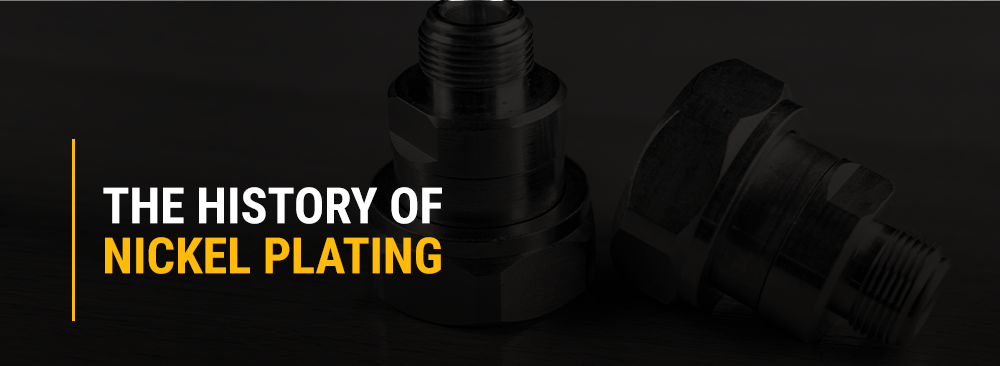The Nickel Plating History: Understanding Its Benefits and Uses in Today’s Industries

Nickel, a metal discovered in 1751, is known for its corrosion resistance. The name “nickel” is thought to be a shortening of kupfernickel, a German word that means “devil’s copper.” Nickel’s corrosion resistance and strength make it an ideal metal for use in plating, as the nickel helps to protect other metals. Along with strengthening materials, nickel plating can help to improve the appearance of metals, making them shinier and brighter.

Nickel plating accounts for 8% of all first-use nickel. Other uses of the metal include the production of stainless steel, battery production and the production of metal alloys. Learn more about the history and benefits of nickel plating, as well as the methods used.
Explore the Rest of Our Electroless Nickel Plating Guide:
The Origins of Nickel Plating
The process of electroplating, during which a thin layer of metal is applied on top of another material, was invented at the start of the 19th century by Luigi Brugnatelli, an Italian chemist. Although Brugnatelli worked with gold and was rebuffed by Napoleon Bonaparte, his work was published in a scientific journal and would inspire other scientists.
Several decades later, scientists continued to experiment with the process of plating metal on metal. In England, inventor John Wright demonstrated that potassium cyanide worked as an electrolyte for gold and silver. Later, two cousins, Henry and George Richard Elkington, successfully used potassium cyanide to develop a feasible electroplating method for gold and silver and are largely credited with bringing electroplating into wider use.
While Wright and the Elkingtons were exploring the use of electroplating for the production of costume jewelry and for artwork, such as sculpture, others were experimenting with the use of electroplating and electrolysis in medicine. Golding Bird, a British physician, developed a process of applying nickel sulfate or chloride to platinum. Later experiments, carried out by scientists in Britain and the U.S., revealed that a nickel ammonium sulphate solution was ideal for use as a bath in the electroplating process.
In the U.S., Dr. Isaac Adams patented a nickel ammonium sulphate bath in the late 1800s. Dr. Adams insisted that the bath be neutral and free from any acids or alkaline reactions. His neutral bath was soon accepted as the standard.
In 1916, another American doctor, Oliver P. Watts developed the solution for what’s become known as the Watts Bath or the Watts Nickelplating Solution:
- Nickel Sulphate (NiSO4.6 H2O): 240 – 300g/L-1
- Nickel Chloride (NiCl2.6 H2O): 30 – 90 g/L-1
- Boric Acid (H3BO3): 30 – 45 g/L-1
The exact proportions of the solution can vary based on the use. The temperature of the bath is usually between 40 and 60 degrees Celsius, and the pH is between 3.5 and 4.5.
Benefits of Nickel Plating
Nickel plating can greatly improve the quality of the plated material. Among some of the benefits of the process include:
- Improved wear resistance: The nickel plating process increases a material’s hardness, thereby enhancing its resistance to wear and tear. The enhanced durability extends the life span of the components and helps reduce maintenance costs.
- Improved strength and hardness: Beyond high wear resistance, nickel plating also increases the hardness of the underlying metal, effectively improving its resistance to abrasion and ability to withstand demanding applications.
- Increased corrosion resistance: Nickel plating creates a protective layer on the material, which enhances its corrosion-resistant properties. This prevents the underlying metals from rusting and deteriorating due to oxidation and prolonged exposure to harsh elements.
- Enhanced adhesion properties: Nickel has strong adhesion properties, which enhance the mechanical properties of parts and components. This characteristic also makes nickel a suitable choice for undercoating.
- Higher temperature resistance: Nickel is known for having one of the highest melting points among all plating metals, at 1455°C or 2651°F. Its natural ability to tolerate extremely high temperatures also gives it high heat resistance.
- Better conductivity: Nickel plating provides good conductivity to electrical components, which is essential to their performance in various electrical applications.
- Enhanced visual appeal: Nickel plating adds brightness and luster to the material, which contributes to its visual appeal. It gives products a more attractive appearance, making it advantageous for industries such as automotive and consumer goods. In addition to a brighter appearance, the nickel plating process can also give a material a matte, shiny or satin finish.
- Uniform coverage: The nickel plating process, specifically electroless nickel plating, delivers uniform amounts of nickel deposits to the material regardless of its specific geometries. The uniform coverage helps ensure consistent performance for the components.

How Nickel Plating Has Changed Through the Years
One of the biggest shifts in the nickel plating process over the years has been the move from electroplating, using a chemical bath and electrical charge, to electroless nickel plating. Electroless nickel plating uses a reduction, or a controlled chemical process, to apply nickel to a material, rather than an electrical charge.
Electroless nickel plating was first developed in the middle of the 20th century. Abner Brenner and Grace Riddell, from the National Bureau of Standards, published the results of their work in the Journal of the Research of the National Bureau of Standards in 1947.
The pair wanted to reduce oxidation of the components of the chemical bath. They sought to do so by adding reducing agents to it, such as sodium hypophosphite. Using sodium hypophosphite, the researchers discovered that the amount of nickel deposited onto a material was more than the amount that was theoretically allowed. Soon after their discovery of the effectiveness of sodium hypophosphite as a reducing agent, the pair determined that the deposition of nickel took place even without an external current. The chemical reduction allowed the deposition to occur because it transformed the nickel itself into a catalytic surface.
Compared to other types of nickel plating, including nickel electroplating, electroless nickel plating offers several benefits, such as:
- Produces more uniform deposits, even on top of uneven surfaces.
- Allows for direct plating on non-conductive materials.
- Allows for deposition on isolated areas.
- Deposits have better corrosion resistance.
- Allows for bulk plating.
Advances have also taken place in the process of nickel electroplating over the years. One such advance is the development of flash nickel plating. During flash nickel plating, a strike layer or flash layer is added to the process. The flash layer adheres the nickel to the base material. As soon as 0.1 micrometers of nickel adheres to the material, a current density of a lower quality is used, which helps to speed up the completion process. Flash plating is ideal for use when other types of metal need to be adhered to the base material and when nickel itself serves as a poor adherent. Copper is often used as a buffer in strike or flash plating.
Industrial Uses of Nickel Plating
Several industries use nickel plating and take advantage of the improved strength and wear resistance that results from adding nickel to a material. The versatility of nickel plating makes it a popular technique among a wide range of industries. These include:
- Automotive: Nickel plating helps increase the corrosion resistance of automotive components, such as bolts, gearbozes, parking brakes and engine parts.
- Aerospace: In the aerospace industry, nickel plating can be used to improve aircraft function and safety. It helps enhance wear resistance and reduce friction for various aircraft parts, such as landing gear, fuel systems and engine components.
- Consumer electronics: Nickel plating increases the functionality and reliability of products, such as processors and circuits.
- Medical devices: Nickel plating improves the medical devices’ ability to resist wear and corrosion, as well as their biocompatibility. It enhances the overall safety and longevity of medical equipment.
- Manufacturing: Nickel plating increases the hardness and wear resistance of manufacturing tools, dies and machinery. This plays a crucial role in reducing the need for maintenance and replacement.
- Power generation: In high-stress environments like power generation, nickel plating enhances resistance to wear and corrosion, especially for parts such as generators and turbines.
Electroless Nickel Plating From Hard Chrome Specialists
There are times when hard chrome plating is the right choice for your project needs and times when nickel plating is more appropriate. Learn more about the benefits of electroless nickel plating and find out the difference between electroless and electrolytic nickel plating.
Hard Chrome Specialists has been helping customers with their finishing needs since 1988. We perform electroless nickel plating and hard chrome plating for all kinds of projects. No project is too large or small. Talk to our experts today to find the plating service suitable for your needs.

